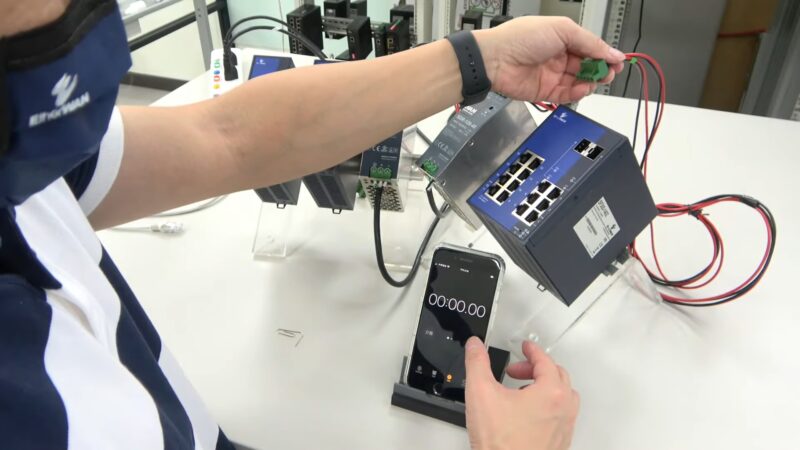Reliable networks are more important than ever, as businesses use them to access corporate and cloud resources. Users are constantly connected via mobile devices throughout the day and night. For many companies, their networks are the primary point of contact for delivering products and services to their customers.
A network outage, then, whether it’s caused by equipment failure, an unexpected cyberattack, or some form of human error, can be devastating for a business. Every moment of system downtime translates into very real financial losses in the form of lost revenue, diminished brand reputation, and missed opportunities.
Whether they’re relying on a cloud provider, on premises data center, or a colocation data center for their network services, it’s vital for companies to understand what kind of network redundancy systems are in place to protect them from downtime.
What Is Redundancy in Networking?
Network redundancy is the process of adding additional instances of network devices and lines of communication to help ensure network availability and decrease the risk of failure along the critical data path.
The underlying premise that explains the importance of network redundancy is simple. Without any backup systems in place, all it takes is one point of failure in a network to disrupt or bring down an entire system. Redundancy in networks helps to eliminate single points of failure to ensure better network stability and uptime in the face of events that would otherwise take the network offline.
Forms of Network Redundancy
Generally speaking, there are two forms of redundancy that data centers use to ensure systems will stay up and running:
- Fault Tolerance: A fault-tolerant redundant system provides full hardware redundancy, mirroring applications across two or more identical systems that run in tandem. Should anything go wrong with the primary system, the mirrored backup system will take over with no loss of service. Ideal for any operations in which any amount of downtime is unacceptable (such as industrial or healthcare applications), fault-tolerance redundant systems are complex and often expensive to implement.
- High Availability: A software-based redundant system, high availability uses clusters of servers that monitor one another and have failover protocols in place. If something goes wrong with one server, the backup servers take over and restart applications that were running on the failed server. This approach to network redundancy is less infrastructure intensive, but it does tolerate a certain amount of downtime in that there is a brief loss of service while the backup servers boot up applications.
Network Redundancy and Infrastructure
One of the first steps of a network redundancy plan is to create a network strategy that reviews existing infrastructure. After all, even the most extensive software redundancies won’t amount to very much if servers don’t have electricity.
A quality colocation data center should have extensive backup systems in place to ensure that power will always be available. Well-maintained UPS systems can ensure that servers can switch over from electrical power to backup generator power without losing any data or applications.
How to Optimize Network Redundancy

How can organizations optimize their network redundancy to boost fault tolerance and ensure high availability? There are several best practices to follow to create an optimal redundancy network:
Backing Data Up in an Offsite Location
All valuable data should be backed up regularly, preferably in another location. A good data center location strategy maps out the best places to replicate and store data so it can be easily accessed in the event that other redundant systems fail and the main network goes down. By using more than one data center, companies can ensure that even if some disaster occurs, they will be able to carry on with minimal disruption.
Frequently Test Backup Systems and Keep Them Well-Maintained
Colocation data centers regularly conduct tests to assess the integrity of their backup systems and redundant networks. They can test different connections by physically disconnecting hardware to make sure failover occurs as anticipated. If things do not go as planned during testing, data center managers then create an after-action report that lists the items they need to fix as a result of the testing. They also create a procedure to follow for both automatic and manual flip over.
Consider the Risk of Cyberattacks

Not all network failures are caused by simple accidents or natural disasters. Sometimes, networks can be brought down by malicious actors targeting the business with various kinds of cyberattacks—such as ransomware that renders critical data useless, malware that renders systems inoperable, or DDoS attacks that clog a network so that nobody can use it.
Considering these cyberattacks and creating incident response plans that can counter them is crucial for ensuring network resiliency in the face of modern cyber threats. Network redundancy can be a crucial aspect of many cyber incident response plans.
What Are DDoS Attacks?
Distributed denial of service (DDoS) attacks are a type of cyberattack where the goal of the attacker is to render a target network or service unusable. In many DDoS attacks, the attacker uses a large network of malware-compromised machines to overload a network with access requests.
There are several distinct types of DDoS attacks that each target different layers of a network:
- Volumetric attacks simply overload a target by consuming all available bandwidth;
- Protocol attacks target vulnerabilities in TCP handshake protocols to keep target systems busy;
- Application layer attacks that ping servers with HTTP requests to load a webpage; and
- Multi-vector attacks that mix and match DDoS strategies to make themselves more complicated and difficult to counter.
In 2020, these attacks became larger than ever before, with AWS being targeted by a 2.3 Tbps (Terabits per second) DDoS attack that leveraged CLDAP (Connection-less-Lightweight Directory Access Protocol) web servers to amplify the size of the attack.
Many networks are simply unprepared to deal with the avalanche of access requests that these attacks unleash in an effort to crash targeted servers. Even worse, volumetric cyberattacks are relatively easy to execute, making them particularly appealing for hackers looking to disrupt network services.
How to Prevent DDoS Attacks
While many companies offer DDoS mitigation services, one of the best methods for preventing these attacks is implementing redundant networks with flexible internet access. By blending a variety of ISPs, data centers can leverage their connectivity to help reroute network services when a DDoS attack is underway.
Modern businesses require a continuous connection to the internet and cloud for mission-critical applications and resources. Without network redundancy, the failure of one device can take down an entire network, and it sometimes takes hours if not days to restore services.
Organizations must weigh the cost of redundancy against the risk of an outage. In most cases, redundant networks will offer significant value. By creating and implementing a plan for network redundancy, they can ensure that their mission-critical applications are still accessible during times of need.
FAQ
How does network redundancy affect latency?
Generally, network redundancy can improve latency by providing alternative paths for data transmission. However, if not properly configured, it can also introduce latency due to the complexity of multiple pathways.
What is the difference between active-active and active-passive redundancy?
In active-active redundancy, all systems are running and sharing the load simultaneously. In active-passive, one system is active while the other is on standby, ready to take over if the active system fails.
How does network redundancy relate to disaster recovery?
Network redundancy is a component of a broader disaster recovery plan. While redundancy ensures network availability in case of failures, disaster recovery encompasses a wider range of strategies including data backup, recovery points, and recovery time objectives.
Can network redundancy protect against all types of cyberattacks?
While network redundancy can mitigate the impact of certain attacks like DDoS, it is not a comprehensive solution against all types of cyber threats. Additional security measures such as firewalls, intrusion detection systems, and regular software updates are also necessary.
Is network redundancy only for large enterprises?
No, network redundancy is crucial for businesses of all sizes. Small to medium-sized businesses may also face significant losses due to network downtime and should consider implementing redundancy measures.
What are the costs associated with implementing network redundancy?
The costs can vary depending on the complexity of the network and the redundancy methods used. While initial setup costs can be high, the long-term benefits often outweigh the initial investment.
Final Words
In today’s interconnected world, network redundancy is not just an option but a necessity. The cost of network downtime can be devastating, affecting not just revenue but also brand reputation and customer trust. By understanding and implementing network redundancy, organizations can mitigate risks and ensure continuous service availability. Whether it’s protecting against hardware failures, human errors, or cyberattacks, a well-planned network redundancy strategy is your first line of defense.








